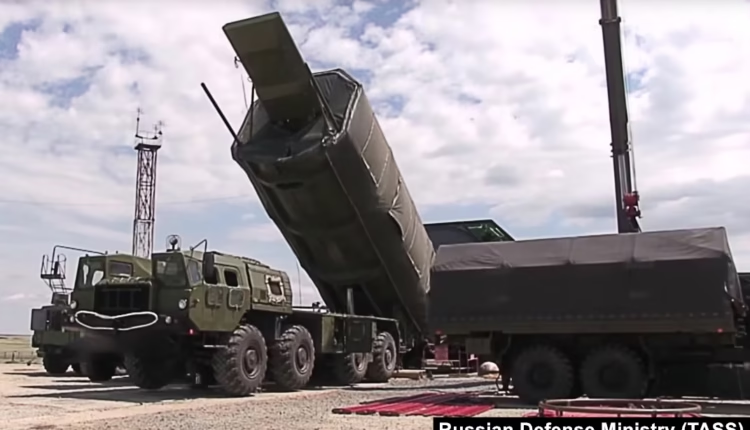Russia Raises Nuclear Stakes With RS-28 Sarmat Missile Amid Rising Tensions With U.S.
As tensions between Washington and Moscow spiral into dangerous new territory, Russia is once again flexing its nuclear muscles — this time with an ominous reminder of its most powerful intercontinental ballistic missile: the RS-28 Sarmat, also dubbed “Satan II” by Western analysts.
The Kremlin has responded to the reported deployment of two U.S. Ohio-class nuclear submarines near Russian territorial waters by showcasing what it calls a “game-changing deterrent” capable of overwhelming any Western missile defence system.
This tit-for-tat escalation signals a sharp return to Cold War-style posturing, with both nuclear powers sending unmistakable warnings in an increasingly volatile geopolitical environment marked by the Ukraine war, NATO expansion, and the global reshuffling of strategic alliances.
The RS-28 Sarmat: Russia’s Nuclear Vanguard
Described by President Vladimir Putin as the “backbone” of Russia’s future strategic missile forces, the RS-28 Sarmat is the most advanced ICBM (intercontinental ballistic missile) in the Kremlin’s arsenal. Developed by Makeyev Rocket Design Bureau, the missile is intended to replace the aging R-36M “Satan”, a product of the Soviet Union’s Cold War-era military engineering.
After years of secrecy and development delays, the RS-28 finally underwent its first full-scale launch test on April 20, 2022, from the Plesetsk Cosmodrome in northern Russia. Russian officials hailed the test as a success, asserting that the missile had met all parameters and marked a major leap in offensive nuclear capabilities.
Terrifying Capabilities Beyond Existing Norms
What sets the RS-28 apart from its American and Chinese counterparts is not just its immense size, but the scale of destruction it can potentially unleash and its evasive flight characteristics:
- Maximum Range: Estimated at 18,000 kilometers, the Sarmat can strike virtually any location on Earth. Unlike most ICBMs that follow predictable trajectories over the Arctic, the RS-28 can be launched via both North and South Pole routes, bypassing the majority of Western early warning radars and missile defence installations.
- Weight & Size: Weighing a colossal 208 tonnes and measuring approximately 35 meters in length, it is among the heaviest missiles ever developed.
- Warhead Capacity: The RS-28 can carry 10 to 15 nuclear warheads, each capable of hitting independent targets using the MIRV (Multiple Independently Targetable Reentry Vehicle) system. This makes it possible for one missile to devastate several cities in a single launch.
- Hypersonic Payloads: Some variants of the Sarmat are reportedly fitted with Avangard hypersonic glide vehicles, which can travel at speeds of Mach 20+ while performing mid-course maneuvers. These gliders render current U.S. and NATO missile defences — including THAAD and GMD (Ground-based Midcourse Defense) — largely ineffective.
Strategic Implications: More Than a Show of Strength
Russia’s revival of the Sarmat narrative is not merely a demonstration of military might, but a strategic move calculated to counter what it perceives as Western aggression and encirclement.
The Kremlin has stated that the deployment of U.S. nuclear-capable submarines close to its maritime boundaries is a clear provocation — one that may force Russia to reassess its nuclear posture.
Moscow sees the Sarmat as a credible second-strike deterrent, ensuring that any first attack on Russian soil would be met with massive retaliation.
Analysts believe this deterrence logic echoes the Cold War-era doctrine of Mutually Assured Destruction (MAD) — an unsettling reminder of how easily strategic calculations could spiral into catastrophe.
In comparison:
- The U.S. LGM-30G Minuteman III has a range of around 13,000 km and carries a maximum of 3 MIRVed warheads.
- China’s DF-41, the most powerful in the People’s Liberation Army Rocket Force, is estimated to have a range of 12,000–15,000 km, with 10 10-warhead capacity.
However, neither the Minuteman nor the DF-41 is believed to combine the massive throw weight, trajectory flexibility, and hypersonic payload versatility of the RS-28.
Nuclear Brinkmanship in 2025: Return of the Arms Race?
This latest development reflects a rapidly intensifying arms race, with all major nuclear powers — including Russia, the U.S., and China — actively modernising and expanding their strategic arsenals.
The U.S. has already allocated over $100 billion towards upgrading its nuclear triad, including new ICBMs under the Sentinel Program, slated to replace the Minuteman series.
China, for its part, has accelerated the construction of nuclear missile silos and invested heavily in hypersonic weapons, cyberwarfare, and AI-based targeting systems.
Russia, facing extensive Western sanctions and international isolation over its invasion of Ukraine, appears to be doubling down on nuclear signaling — both as a deterrence mechanism and as a tool of geopolitical messaging.
Growing Global Anxiety
The emergence of weapons like the RS-28 Sarmat and the deployment of hypersonic delivery systems have raised serious concerns among global security analysts, arms control advocates, and diplomats.
The collapse of key arms control treaties — including the INF Treaty (2019) and New START, which is set to expire in 2026 unless extended — leaves the world without effective guardrails on the growth and deployment of these weapons.
As traditional lines of communication between nuclear superpowers remain fragile or broken, the risk of miscalculation or escalation — whether accidental or deliberate — becomes ever more real.
Efforts by global watchdogs and multilateral institutions to reinitiate dialogue have yielded little progress, with deepening distrust between NATO and Russia stalling most attempts at nuclear de-escalation.
Conclusion: A Dangerous New Normal
Russia’s renewed emphasis on the RS-28 Sarmat is a clear signal that nuclear brinkmanship is back on the global stage. With military doctrines now increasingly relying on hypersonic tech, stealth trajectories, and second-strike capabilities, the threshold for nuclear confrontation seems lower than it has been in decades.
In the absence of robust arms control frameworks and confidence-building measures, the world now faces the prospect of a 21st-century Cold War, one that is faster, more unpredictable, and potentially deadlier.
#RussiaUSConflict #RS28Sarmat #SatanII #NuclearTensions #VladimirPutin #ICBM #HypersonicWeapons #Avangard #USRussiaTensions #ColdWar2 #NuclearDeterrence #Geopolitics2025 #SarmatMissile #OhioClassSubmarines #ArmsRace #StrategicStability #NuclearWeapons #DefenseTech #MIRV #AvangardGlideVehicle #Mach20 #MutuallyAssuredDestruction #RussiaMilitary #GlobalSecurity

